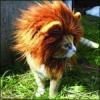Programatically?
It is possible in the sense that can be done, but I don't think it's feasible because the whole point of having a normal texture is because the code can't figure how to do itself...
Check this image. There's a perfect example in the middle of the texture of something that is bumped out but it doesn't appear so from the texture, so only something human looking at it could figure it out.
So if you do it programatically, I think at best (easily) you could do the texture the wrong way, which would be simply by making another texture in black/white shades.
But still, if you can figure some algorithm to make the code "realize" where it is supposed to have height differences... or if you just want to try it out, you can do a simple one using C++ and Bitmaps.
All images in their raw form are bytes that are usually in the format RGB or RGBA.
You can check for various libs (free) for loading images from various formats (such as stb_image, really easy to set up and use) into an array of unsigned char*, and then... well, you can parse each "pixel" by getting the format of it and doing whatever algorithm you want to.
unsigned char* imageBytes = new unsigned char[imageTotalByteSize];
//fill the variable either loading yourself or using a lib
for(unsigned long i = 0; i < imageTotalByteSize; i++)
{
imageBytes[0] = 0; //number from 0~255 representing the first pixel's Red channel
imageBytes[1] = 0; //number from 0~255 representing the first pixel's Blue channel
imageBytes[2] = 0; //number from 0~255 representing the first pixel's Green channel
//Do whatever you want with the first pixel - I just set it to black
}
//Actually you might want to check it depending on the loader you use, some of them invert the image (meaning you start at the bottom) or some might even load it without doing any sorting (so BMPs would be at BGR format instead of RGB)
I'm guessing you could read the entire image, and check if the pixel's darker than a certain amount (all three values < 75) or just take the average of the three or something so it makes a black/white one.
Then you either write over these values or write in another array of the same size. But that's still not yet done, the array is only some data in the memory not the actual image file.
Now you have to save that data into an image file of your own, and I'm not sure how you can do it but surely there's a lib for that. If you don't want to take your time setting it up, check the BMP's file format, it's really easy and fast to make your own (because it's uncompressed, so you only have to worry about the headers, which is setting the right width/height, bits, etc) and then writing it to a binary file, name it "myImage.bmp" and that's it...







